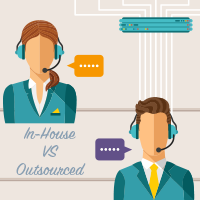 If you’re already managing an in-house call center, you know that navigating the natural peaks and valleys of call volume presents a complex challenge when calculating call center costs. You know that the ratios and formulas are multifaceted, which can make a direct comparison between in-house and outsourcing a little difficult.
If you’re already managing an in-house call center, you know that navigating the natural peaks and valleys of call volume presents a complex challenge when calculating call center costs. You know that the ratios and formulas are multifaceted, which can make a direct comparison between in-house and outsourcing a little difficult.
This blog post isn’t going to address the indirect costs of taking your eye off of your core business in order to run an in-house call center – that’s a discussion for another day. But when you need to present a business case complete with outsourced contact center costs, you need to break down the numbers in a way that makes sense. Below, we look at the multiple factors that go into the call center cost comparison.
Productive vs. Non-Productive Agent Time
In addition to investing in agent recruiting when you staff and train an in-house team, you’re paying for every minute of the time they’re there. From the moment they enter the office, their time is spent settling in for the day, taking calls, taking breaks, engaging in training and coaching activities, as well as the time spent in ready waiting during lulls in arrival patterns. Each minute affects your bottom line.
In sharp contrast, when you outsource your call center, you’ll only be paying for productive agent time. Typically, you can project an estimated 85% productivity rate, so instead of paying 100% of your agent’s work hour, you can cut those hourly costs by about 15%. That represents significant savings right out of the gate.
Management of Call Center Agents
When staffing your in-house call center, you’ll also have to hire front line supervisors or coaches as well as program managers for the team. In doing so, you’ve just added yet another line to your call center budget.
In contrast, when you outsource your call center, program management costs (including those frontline supervisors) should be automatically included in the agent rate. (If your vendor doesn’t include program management in your per minute or per hour rate, we should talk…)
Call Center Reporting
Every successful call center needs to keep a painstakingly close eye on quality assurance. The metrics produce an abundance of data, and include factors like first-call resolution, response times, average handling time, customer satisfaction, service level, net promoter scores, and more.
A great call center reporting team will go beyond the gathering of data to offering value-added analysis that supports your decision-making. Every call center needs information management professionals supported by appropriate tools and technology to fully leverage the data you absorb daily. Add at least two more budget lines to your in-house call center here. On the other hand, when you consider outsourcing your call center, this cost is usually already tied into the agent rate.
Call Center Infrastructure
With in-house call centers, you’re on the hook for every component of the supporting infrastructure. These overhead costs include your facilities, telephony, workstations, and more; not to mention any IT staff you’ll need to hire to provide tech support.
This is a cost that isn’t going to go away – every three to five years, you’re going to start thinking about upgrading. Ask your tech team: major systems upgrades are expensive – both in terms of direct expense and the time and focus of your internal tech resources.
Once again, in an outsourced arrangement, the hard and soft costs of systems, maintenance, and upgrades are going to be carried by your call center partner.
Call Center HR Support
When considering your in-house call center overhead costs, don’t forget the foundational expense of recruiting, payroll and taxes, and benefits management. Additionally, these costs can fluctuate depending on your turnover rate. And of course, the HR staff themselves need to be factored into your calculations.
As with all the above factors, HR expenses are by default included in your outsourced per minute or fixed rate.
Other Factors
Finally, there are a number of advantages you’ll gain from outsourcing that will add further value to your investment, which may not be realized through in-house efforts. These factors result in both reduced FTE and increased potential for overall call center success. They include:
- Cutting-edge call center technology for efficient call distribution
- Cross-training to maximize staffing for peaks and valleys of call volume
- Shared pool options for lower volume hours of operation
- Deep expertise in forecasting for maximized efficiency
- Risk mitigation in the management of both human and technology resources

Your Bottom Line
Though this is an abbreviated guide, it should give you a good idea of how all your costs break down so you’re not left trying to compare apples to oranges. At Blue Ocean, we know that calculating call center costs can be a big headache. If you’re looking for some more in-depth insight on the math, don’t hesitate to contact us today.



